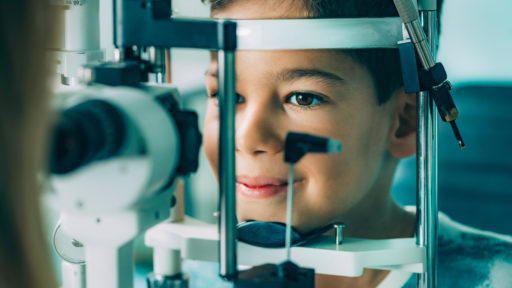What is glaucoma?
Glaucoma is a condition in which the normal fluid pressure inside the eyes (intraocular pressure or IOP) slowly rises as a result of the fluid aqueous humor–which normally flows in and out of the eye–not being able to drain properly. Instead, the fluid collects and causes pressure damage to the optic nerve (a bundle of more than 1 million nerve fibers that connects the retina with the brain) and loss of vision.
What causes glaucoma?
While doctors used to think that high intraocular pressure (also known as ocular hypertension) was the main cause of optic nerve damage in glaucoma, it is now known that even persons with normal IOP can experience vision loss from glaucoma. Thus, the causes are still unknown.
What are the different types of glaucoma?
- Open-angle glaucoma. With this most common type of glaucoma, the fluid that normally flows through the pupil into the anterior chamber of the eye cannot get through the filtration area to the drainage canals, causing a buildup of pressure in the eye. Nearly 3 million Americans–half of whom do not know they have the disease–are affected by glaucoma each year.
- Low-tension or normal-tension glaucoma. While normal intraocular pressure ranges between 12 to 21 mm Hg, an individual may have glaucoma even if the pressure is within this range. This type of glaucoma presents optic nerve damage and narrowed side vision.
- Angle-closure glaucoma. In angle-closure glaucoma, the fluid at the front of the eye cannot reach the angle and leave the eye because the angle becomes blocked by part of the iris. This results in a sudden increase in pressure and is generally a medical emergency, requiring immediate treatment to improve the flow of fluid.
- Childhood glaucoma. Childhood glaucoma is a rare form of glaucoma that often develops in infancy, early childhood, or adolescence. Prompt medical treatment is important in preventing blindness.
- Congenital glaucoma. Congenital glaucoma, a type of childhood glaucoma, occurs in children born with defects in the angle of the eye that slow the normal drainage of fluid. Prompt medical treatment is important in preventing blindness.
- Primary glaucoma. Both open-angle and angle-closure glaucoma can be classified as primary or secondary. Primary glaucoma cannot be contributed to any known cause or risk factor.
- Secondary glaucoma. Both open-angle and angle-closure glaucoma can be classified as primary or secondary. Secondary glaucoma develops as a complication of another medical condition or injury. In rare cases, secondary glaucoma is a complication following another type of eye surgery.
What are the symptoms of glaucoma?
Most people who have glaucoma do not notice any symptoms until they begin to lose some vision. As optic nerve fibers are damaged by glaucoma, small blind spots may begin to develop, usually in the side or peripheral vision. Many people do not notice the blind spots until significant optic nerve damage has already occurred. If the entire nerve is destroyed, blindness results.
One type of glaucoma, acute angle-closure glaucoma, does produce noticeable symptoms because there is a rapid buildup of pressure in the eye. The following are the most common symptoms of this type of glaucoma. However, each individual may experience symptoms differently. Symptoms may include:
- Blurred or narrowed field of vision
- Severe pain in the eye(s)
- Haloes (which may appear as rainbows) around lights
- Nausea
- Vomiting
- Headache
The symptoms of acute angle-closure glaucoma may resemble other eye conditions. Consult a doctor for diagnosis immediately if you notice symptoms as this type of glaucoma is considered a medical emergency requiring prompt medical attention to prevent blindness.
How is glaucoma diagnosed?
In addition to a complete medical history and eye examination, your eye care professional may perform the following tests to diagnose glaucoma:
- Visual acuity test. The common eye chart test (see above) that measures vision ability at various distances.
- Pupil dilation. The pupil is widened with eye drops to allow a close-up examination of the eye’s retina.
- Visual field. A test to measure a person’s side (peripheral) vision. Lost peripheral vision may be an indication of glaucoma.
- Tonometry. A standard test to determine the fluid pressure inside the eye.
What are the risk factors for glaucoma?
Although anyone can develop glaucoma, some people are at higher risk than others. The following are suggested as risk factors for glaucoma:
- Race. Glaucoma is the leading cause of blindness for African-Americans.
- Age. People over age 60 are more at risk for developing glaucoma.
- Family history. People with a family history of glaucoma are more likely to develop the disease.
- High intraocular pressure. People with an elevated (greater than 21 mm Hg) intraocular pressure (IOP) are at an increased risk.
The National Eye Institute, part of the National Institutes of Health, recommends that anyone in these risk groups receive an eye examination with dilated pupils every two years.
Treatment for glaucoma
Specific treatment for glaucoma will be determined by your doctor based on:
- Your age, overall health, and medical history
- Extent of the disease
- Your tolerance for specific medications, procedures, or therapies
- Expectations for the course of the disease
- Your opinion or preference
While glaucoma cannot be cured, early treatment can often control it. Treatment may include:
- Medications. Some medications cause the eye to produce less fluid while others lower pressure by helping fluid drain from the eye.
- Conventional surgery. The purpose of convention surgery is to create a new opening for fluid to leave the eye.
- Laser surgery (also called laser trabeculoplasty). Several types of surgical procedures can be performed with a laser that are used to treat glaucoma, including:
- Trabeculoplasty. In this, most common type of laser surgery to treat open-angle glaucoma, a laser is used to place “spot welds” in the drainage area of the eye (known as the trabecular meshwork) that allows fluid to drain more freely.
- Iridotomy. In this procedure, the surgeon uses the laser to make a small hole in the iris–the colored part of the eye–to allow fluid to flow more freely in the eye.
- Cyclophotocoagulation. A procedure that uses a laser beam to freeze selected areas of the ciliary body–the part of the eye that produces aqueous humor–to reduce the production of fluid.
- Tube shunt. This implantable drainage device creates an artificial pathway in the eye. It is made from a miniature, stainless steel tube, and can be implanted in less than five minutes. A tube shunt is usually selected after it is determined that a patient cannot benefit from conventional surgical treatments.
In some cases, a single surgical procedure is not effective in halting the progress the glaucoma, and repeat surgery and/or continued treatment with medications may be necessary.


